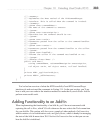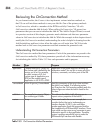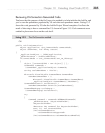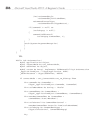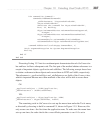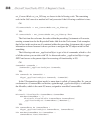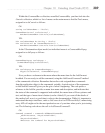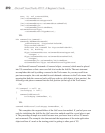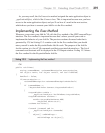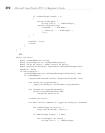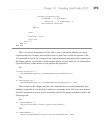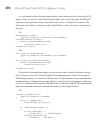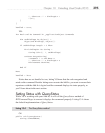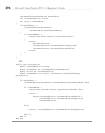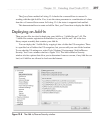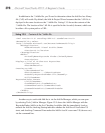
Chapter 13: Extending Visual Studio 2010 391
As you may recall, the OnConnection method assigned the main application object to
_applicationObject, a field of the Connect class. This is important because now you have
access to the main application object, and you’ll see how it’s used in the next section,
which shows you how to execute your Add-In via the Exec method.
Implementing the Exec Method
Whenever a user starts your Add-In, VS calls the Exec method of the IDTCommandTarget
interface. The Exec method is important because that’s where you add your code to
implement the behavior of your Add-In. The previous sections discussed code that is
generated by VS, but Listing 13-3 contains code for the Exec method that you should
enter yourself to make the KeystrokeFinder Add-In work. The purpose of the Add-In
for this section is to list all VS commands and their associated shortcut keys. The list of
commands and shortcuts will be displayed in the VS Output window. Listing 13-3 shows
the Exec method for the KeystrokeFinder Add-In.
Listing 13-3 Implementing the Exec method
C#:
public void Exec(
string commandName, vsCommandExecOption executeOption,
ref object varIn, ref object varOut, ref bool handled)
{
handled = false;
if(executeOption ==
vsCommandExecOption.vsCommandExecOptionDoDefault)
{
if (commandName ==
"KeystrokeFinder.Connect.KeystrokeFinder")
{
OutputWindow outWin =
_applicationObject.ToolWindows.OutputWindow;
OutputWindowPane outPane =
outWin.OutputWindowPanes.Add(
"Keyboard Shortcuts");
outPane.Activate();
foreach (Command cmd in
_applicationObject.Commands)
{
object[] cmdBindings =
cmd.Bindings as object[];



